Scarlet Tanager (Piranga olivacea) is one of the most strikingly beautiful birds in the North American forest. With their vibrant red plumage and jet-black wings, they stand out like beacons against the green foliage.
These migratory birds are a common sight in the eastern United States during the summer breeding season.
On this page
Breeding Male
Male Scarlet Tanagers have intense crimson-red plumage with black tails and wings. During the non-breeding season, they will molt to more modest colors and resemble a female bird, although they will retain the black wings and tail. They have black eyes and gray bills.
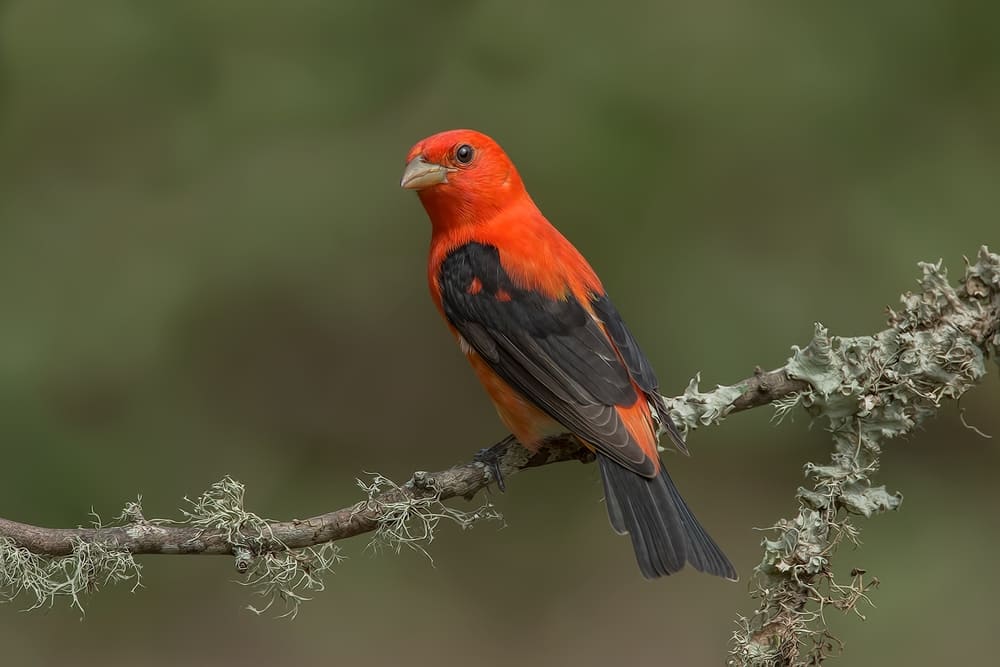
Scarlet Tanager (Male), Galveston Island, Texas
Female
Female Scarlet Tanagers are completely different from their male counterparts and sport dull olive-yellow and olive-green colors. Their wings and tails are darker. Females also have black eyes and gray bills.
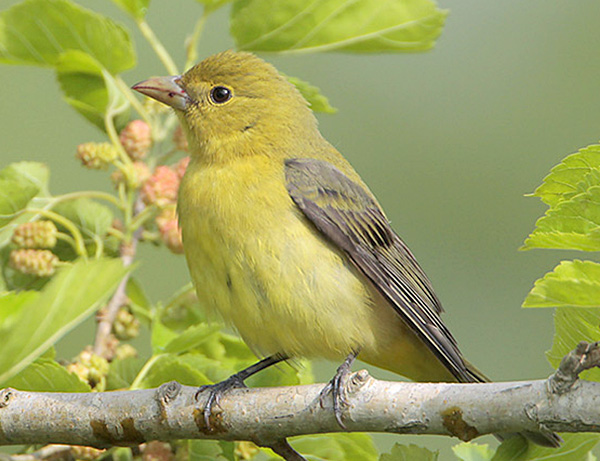
Female. Photograph © Greg Lavaty.
Juvenile
Immature and juvenile Scarlet Tanagers are similar to females and are also olive-green above and yellowish below. They leave the nest around 9-15 days after hatching and the parents take care of them for only 2 more weeks after that.
Overall, birds from either sex grow to be about the same size and measure 6.3-6.7 inches in length, weigh around 0.8-1.3 ounces, and have a wingspan of 9.8-11.4 inches.
Habitat
Scarlet Tanagers mostly inhabit mature deciduous or mixed forests but you can also meet them in young successional woodlands, parks, and suburban areas that have a lot of shade trees. For successful breeding, they require at least 10-12 hectares of unfragmented forest.
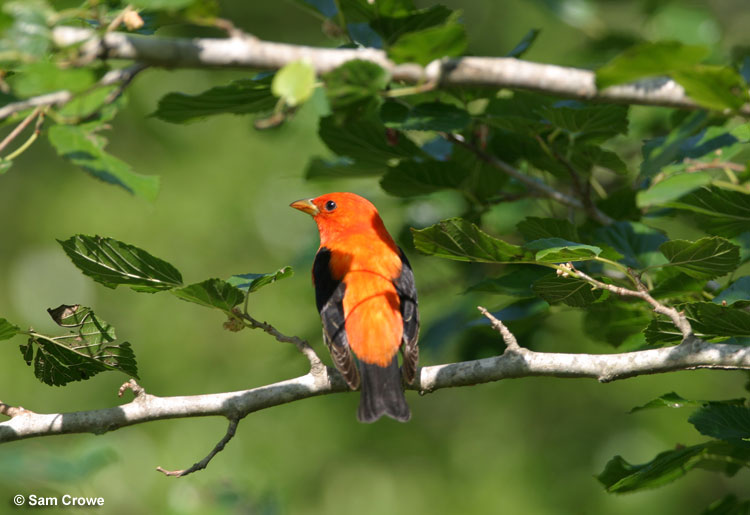
They build their nest 50 feet or more above the ground on a branch that is shaded by leaves or branches and is away from the trunk. They prefer deciduous trees, especially oak. The nest itself is a flimsy cup made of small twigs, plant stalks, grasses, and other fine plant material.
Diet
Scarlet Tanagers are omnivores, although they prefer to eat insects. In summer, their diet primarily consists of various insects and invertebrates, such as moths, bees, beetles, caterpillars, ants, butterflies, flies, plant lice, termites, grasshoppers, snails, earthworms, spiders, and dragonflies.
You might see them walking along high branches, and on rare occasions on the ground, or clinging to tree trunks and probing the bark, snatching up insects as they go.
They snap up insects from leaves and flowers while hovering or perching, swallowing smaller ones whole but killing larger ones by pressing them against the tree. The birds catch flying insects from mid-air.
The other, but a smaller part of their diet consists of plant matter, specifically fruit, berries, and buds. Some of their preferred food items from this category are mulberries, sumac, huckleberries, blackberries, raspberries, and others. They resort to eating berries and other plant matter when insect populations are low.
Behavior
Scarlet Tanagers are social, but also territorial when it comes to their territories and nests during the breeding season. Males sing to defend their territories, including nests and foraging areas, which can sometimes end in confrontations and chasing.
They are monogamous birds that take care of their younglings, although they switch partners every season, and their parental care lasts for only two weeks after their offspring leave the nest. Males feed their females during nesting season.
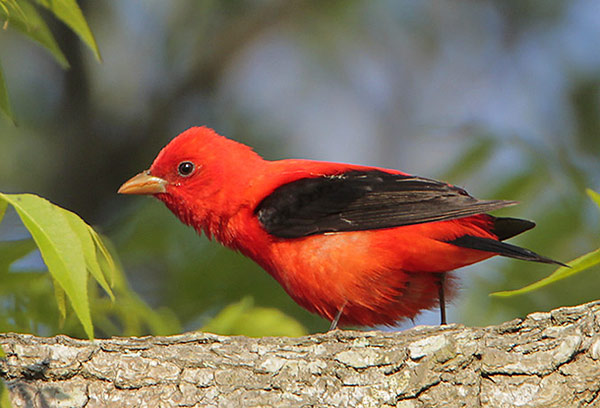
Scarlet Tanagers are a prey item to many predators, both aerial and terrestrial. They respond differently to different threats. Tanagers swoop, mob, chase, and call at most predators, but in the case of crows and Merlins, they become quiet and alert, trying to remain unseen.
Range (and seasonal changes)
Scarlet Tanagers range in the eastern part of North America and northern and western South America. They can be seen in eastern Central America during migration.
These birds are not year-round residents and migrate based on the season. They breed in the eastern part of North America, from the southernmost reaches of Canada to northern Georgia, Alabama, Mississippi, western Carolinas, and Arkansas as far as the deciduous forests go. They migrate mostly at night across the Gulf of Mexico to South America.
Wing shape
Scarlet Tanagers are quite stocky and have short and broad tails, and short but strong wings proportionate to their body. They fly straight with rapid wingbeats to catch insects from the air or hover near branches, trunks, and leaf clusters to snatch up insects.
Fun Facts
- When Scarlet Tanagers catch a bee, wasp, or hornet, they scrape it against the tree to remove their stinger.
- Scarlet Tanagers face many threats caused by exposure, lack of food, predation, forest fragmentation, and parasitism. For example, Cowbirds lay eggs in their nests if the tanagers don’t notice, and the tanagers can’t tell the difference and raise the Cowbird’s offspring along with their own.
- Many cultures and beliefs hold Scarlet Tanagers and tanagers overall in high regard. They’re believed to be sacred birds, a symbol of good luck, hope, and new beginnings.
- The oldest known Scarlet Tanager lived to be at least 11 years and 11 months old. However, in the wild, their life expectancy is usually lower.
Vocalization
Scarlet Tanager’s song is a beautiful series of 4-5 chirruping phrases that have a warbling quality to them. Males sing from a higher perch to defend their territory and whereas females sing as well, then their song is softer and has fewer syllables.
Scarlet Tanagers have many different calls for different purposes. The most common and distinctive one is a higher-pitched chick followed by a lower burr sound. They screech when intruders are near and give more indistinctive chips and twitters when nesting, feeding, and communicating.
Similar Species
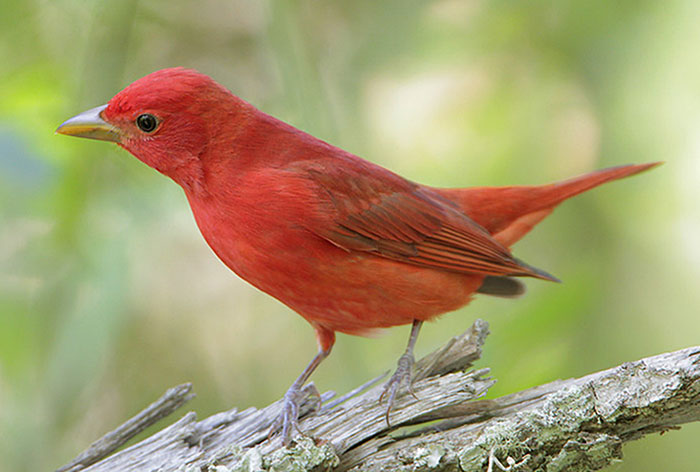
Summer Tanager
Contrary to Scarlet Tanagers, Summer Tanagers are completely red in color. Scarlet Tanagers have black wings and tails.
Females look similar, but female Summer Tanagers are brighter in color and do not have darker wings.
Summer Tanagers are more widespread, ranging to the western side of the USA as well.
Frequently Asked Questions
How rare is it to see a Scarlet Tanager?
In summer, Scarlet Tanagers are fairly common in large deciduous forests but they’re quite hard to see as they like to forage in the upper foliage.
What is special about a Scarlet Tanager?
Breeding male Scarlet Tanagers have striking red plumage contrasted by their black tails and wings. Females, immatures, and non-breeding males, however, have modest olive green and dull yellow plumage.
Where can Scarlet Tanagers be found?
During the breeding season, Scarlet Tanagers can be found in the mature deciduous and mixed forests of the eastern United States. They migrate to northern and western South America for the winter.
What is the difference between a summer tanager and a Scarlet Tanager?
Male Scarlet Tanagers have crimson-red plumage and black wings and tails, whereas male Summer Tanagers are red all over. Female Scarlet Tanagers have duller colors and darker wings whereas female Summer Tanagers are brighter yellow and their wings are yellower as well.

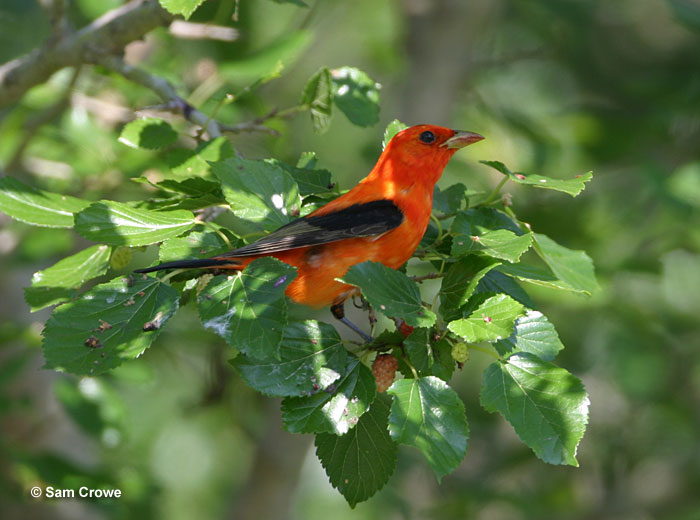
Sharon Pendergrass
Wednesday 13th of March 2024
Do scarlet tanagers live in Ohio? Do they have a crest like a cardinal?
Patrick O'Donnell
Monday 18th of March 2024
@Sharon- Yes! Scarlet Tanagers are common summer residents in Ohio. They do have beautiful red colors but do not have a crest. Look for them in forested areas.